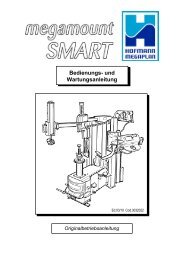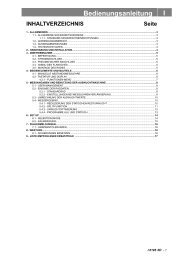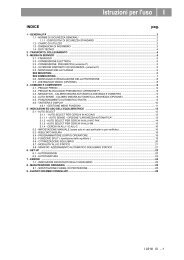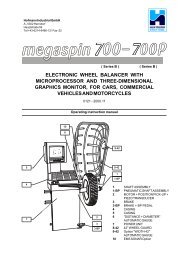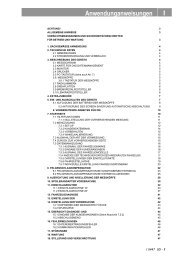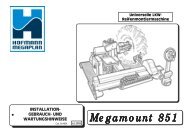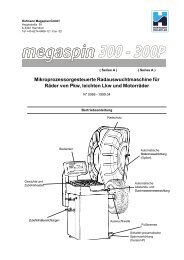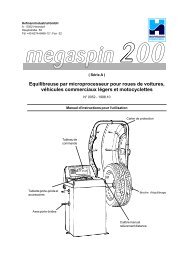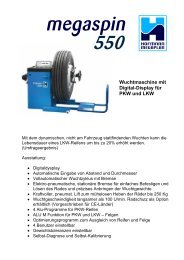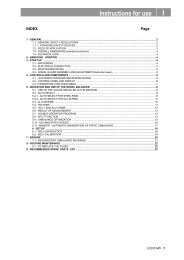Instructions for use I - Hofmann Megaplan
Instructions for use I - Hofmann Megaplan
Instructions for use I - Hofmann Megaplan
You also want an ePaper? Increase the reach of your titles
YUMPU automatically turns print PDFs into web optimized ePapers that Google loves.
7 - ERRORS<br />
During machine operation, various ca<strong>use</strong>s of faulty operation could occur. If detected by the microprocessor,<br />
they appear on the display as follows:<br />
ERROR<br />
MEANING<br />
1 No rotation signal. Could be ca<strong>use</strong>d by faulty position transducer, or something<br />
preventing the wheel from turning.<br />
2 During the measurement spins, wheel speed had dropped below 60 r.p.m. Check<br />
encoder functioning (see Self-diagnostics). Repeat the spin.<br />
3 Unbalance too high.<br />
4 Rotation in opposite direction.<br />
5 Guard open be<strong>for</strong>e start of spin.<br />
7 Fault in reading the machine calibration parameters. Repeat the self-calibration.<br />
8 Fault in reading the machine calibration parameters. Repeat the self-calibration.<br />
General fault in memory of the machine calibration parameters. Contact CEMB<br />
Technical Service Department HOFMANN.<br />
The width value measured is too low. Repeat the width automatic measurement<br />
making sure that the preset distance value is correct.<br />
11 Speed too high during unbalance measurement spins.<br />
12/13/14 DifÞ culty in reading the analog signal. Contact CEMB Technical Service Depart<br />
ment HOFMANN.<br />
15/17 Inside/outside analog signal too high. Contact CEMB Technical Service Depart<br />
ment HOFMANN.<br />
16/18 Inside/outside analog signal too high. Contact CEMB Technical Service Depart<br />
ment HOFMANN.<br />
7.1 - INCONSISTENT UNBALANCE READINGS<br />
Sometimes after balancing a wheel and removing it from the balancing machine, it is found that, upon<br />
mounting it on the machine again, the wheel is not balanced.<br />
This does not depend on incorrect indication of the machine, but only on faulty mounting of the wheel on<br />
the adapter; i.e. in the two mountings, the wheel has assumed a different position with respect to the<br />
balancing machine shaft centre line. If the wheel has been mounted on the adapter with screws, it could<br />
be possible that the screws have not been correctly tightened, i.e. crosswise one by one, or else (as often<br />
occurs) holes have been drilled on the wheel with too wide tolerances.<br />
Small errors, up to 10 grams (0.4 oz) are to be considered normal in wheels locked by a cone; the error is<br />
normally greater <strong>for</strong> wheels fastened with screws or studs.<br />
If, after balancing, the wheel is found to be still out-of-balance when reÞ tted on the vehicle, this could be<br />
due to the unbalance of the car brake drum or very often due to the holes <strong>for</strong> the screws on the rim and<br />
drum sometimes drilled with too wide tolerances. In such case a readjustment could be advisable using<br />
the balancing machine with the wheel mounted.<br />
8 - ROUTINE MAINTENANCE<br />
Switch off the machine from the mains be<strong>for</strong>e carrying out any operation.<br />
8.1 - REPLACEMENT OF THE FUSES<br />
Remove the weight holder tray to gain access to the power PC board where the f<strong>use</strong>s are located (see<br />
Exploded Drawings). If f<strong>use</strong>s require replacement, <strong>use</strong> ones of the same current rating. If the fault<br />
persists, contact the Technical Service Department.<br />
8.2 - ADAPTER TERMINAL OF P SPINDLE<br />
- Always keep the inside felt ring lubricated<br />
NONE OF THE OTHER MACHINE PARTS REQUIRE MAINTENANCE<br />
I 0162 GB - 22



